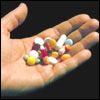New guidance for purchasers of HIV/AIDS medicines

An updated edition of Sources and Prices of Selected Medicines and Diagnostics for People living with HIV/AIDS will be released today. The report provides market information on 74 reviewed products for the treatment and management of HIV/AIDS from 61 manufacturers.
The report gives purchasers of AIDS medicines and diagnostics a range of choices related to suppliers and affordability. The medicines included were selected on the basis of WHO standard treatment guidelines. The list is not exhaustive but covers the most commonly used HIV/AIDS medicines, with paediatric forms included wherever possible.
Improving access to medicines for people living with HIV/AIDS is a challenge for all countries but especially for developing ones. By the end of 2002, UNAIDS estimated that 42 million people in the world were living with HIV/AIDS and that over 95% of these were in poor nations. Last year, 3.1 million people died of the disease, many of them because they had had no access to treatment.
While high prices constitute one of the main barriers to accessing treatment, a few recent initiatives have brought the price of certain medicines down. However, even where affordable alternatives exist, many decision-makers do not have the information they need to identify those manufacturers that can supply the medicines needed. Without such information, there is a risk that low-income countries pay more than necessary – and sometimes more than industrialized countries – to obtain essential medicines. The report helps fill that gap.
This report is the fourth in a series of annual publications of sources and prices surveys commenced in 1999 by United Nations Children’s Fund (UNICEF), UNAIDS, the World Health Organization (WHO) and Médecins Sans Frontières (MSF). The present edition is the result of a survey carried out from December 2002 through February 2003, of 388 manufacturers in 50 countries.
The report includes antiretroviral (ARV) medicines, medicines used to treat a range of opportunistic infections, medicines for use in palliative care, medicines for the treatment of HIV-related cancers and for the management of opioid dependence. It also provides information on a range of test kits for the diagnosis and monitoring of HIV/AIDS.
A new section has been added on the registration status of products in the survey. This information will be useful for people in countries who are in the process of granting market authorization to HIV/AIDS related products.
Finally, the latest edition of an MSF document, Untangling the Web of Price Reductions: a pricing guide for the purchase of ARVs for developing countries has been included as an annex to provide a comprehensive overview of the prices of ARV medicines offered by research-based pharmaceutical companies and some generics manufacturers in low- and middle-income countries.
Sources and Prices 2003 can be found on the following web sites: UNICEF, WHO, médecins sans frontières.
For more informations:
Ms Daniela Bagozzi
Telephone: +41 22 791 4544
Email:bagozzid@who.int
Media Contact
All latest news from the category: Health and Medicine
This subject area encompasses research and studies in the field of human medicine.
Among the wide-ranging list of topics covered here are anesthesiology, anatomy, surgery, human genetics, hygiene and environmental medicine, internal medicine, neurology, pharmacology, physiology, urology and dental medicine.
Newest articles

High-energy-density aqueous battery based on halogen multi-electron transfer
Traditional non-aqueous lithium-ion batteries have a high energy density, but their safety is compromised due to the flammable organic electrolytes they utilize. Aqueous batteries use water as the solvent for…

First-ever combined heart pump and pig kidney transplant
…gives new hope to patient with terminal illness. Surgeons at NYU Langone Health performed the first-ever combined mechanical heart pump and gene-edited pig kidney transplant surgery in a 54-year-old woman…

Biophysics: Testing how well biomarkers work
LMU researchers have developed a method to determine how reliably target proteins can be labeled using super-resolution fluorescence microscopy. Modern microscopy techniques make it possible to examine the inner workings…





















